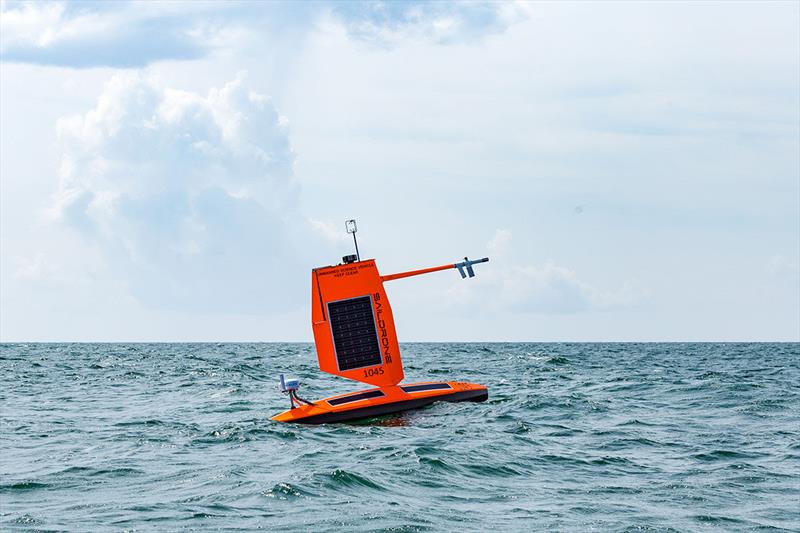
“Hurricane Sam” Saildrone sails back into the eye of the storm
by Saildrone 19 Jul 2023 13:41 UTC

SD 1045 bravely sails toward weather offshore from Charleston, SC © Saildrone
In the early morning hours of Sept. 30, 2021, the Saildrone team—mission managers, pilots, and software and hardware engineers—along with our science partners at the National Oceanic and Atmospheric Administration (NOAA), anxiously watched as Saildrone Explorer SD 1045 sailed closer and closer to a category 4 hurricane. They didn't make any effort to direct the saildrone away from the storm—their goal was to get the vehicle inside it.
Battling massive waves and winds over 100 mph, SD 1045 not only survived Hurricane Sam intact but collected important data about the physical interactions between the ocean and atmosphere that revealed new insights about hurricane intensification.
This summer, SD 1045 has been redeployed for the 2023 Atlantic hurricane season to continue its mission at the forefront of cutting-edge hurricane research.
"SD 1045 sailing through the eye of Hurricane Sam was really a seminal moment for this field campaign with NOAA, proving that we actually could sail into a major hurricane and deliver data in near real time to scientists to help them improve weather forecasting," said Matt Womble, Sr. Director of Ocean Data Programs. "To redeploy SD 1045 this year for the same mission demonstrates the endurance, durability, and reliability of the vehicles Saildrone has built."
Hurricane track forecasting has steadily improved in recent years. However, predicting rapid intensification—when wind speeds increase at least 35 mph over a 24-hour period—is still a significant challenge. To understand how these large and destructive storms grow, scientists need to collect data about the surface fluxes—the exchanges of energy in the forms of heat and momentum—a task that Saildrone's uncrewed surface vehicles (USVs) are uniquely equipped to perform.
SD 1045 is one of 12 vehicles Saildrone has deployed for NOAA this summer. The saildrones will transmit high-frequency metocean data continuously through tropical storms and hurricanes, including air temperature and relative humidity, barometric pressure, wind speed and direction, water temperature and salinity, sea surface temperature, and wave height and period to scientists at NOAA's Atlantic Oceanographic & Meteorological Laboratory (AOML) and Pacific Marine Environmental Laboratory (PMEL).
While Saildrone has sailed vehicles through Hurricane Sam and Hurricane Fiona, data from one or two hurricanes is not enough; scientists need data from multiple storms, big and small, to draw robust conclusions about how they intensify.
After deployment from Charleston, SD 1045 began sailing ESE to a mission domain area that spans North and South Carolina, where it will be stationed for the duration of the mission. NOAA has identified areas where the saildrones have a high probability of intercepting a storm, as indicated by historical data.
"Off the coast of South Carolina is a particularly complex area of the ocean with relatively shallow waters combined with the strong, warm currents of the Gulf Stream that supply energy to a storm. When hurricanes go over these warm waters, they often intensify, potentially right before they make landfall, so it's really important to understand how the ocean interacts with the storms in this area," said Greg Foltz, a NOAA oceanographer and one of the mission's principal investigators.
Saildrone's environmentally friendly uncrewed surface vehicles (USVs) are designed to perform multiple long-endurance missions over many years. Powered exclusively by the wind for propulsion and solar energy for onboard computers and sensors, the 23-foot Saildrone Explorer can deliver maritime data continuously for up to a year to meet a variety of science, mapping, and security objectives.
Prior to the 2021 Atlantic Hurricane mission, SD 1045 sailed from San Francisco to Eugene, OR, to San Diego, and back to San Francisco on a 60-day NOAA mission to assess stocks of Pacific hake and five coastal pelagic species along the US West Coast. Saildrones SD 1031 and SD 1040 have been deployed for all three hurricane missions, among others—SD 1031 previously completed a fisheries mission in the North Sea, and SD 1040 was also used for the 2019 West Coast Fisheries mission.
Read more: More Saildrones Than Ever Deploy for the 2023 Hurricane Season!